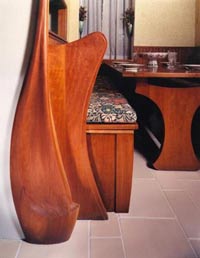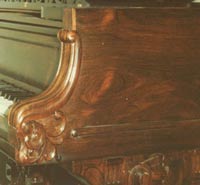|
Wood
Carving is pretty self-explanatory - it's a process taking a solid hunk
of wood, removing the unwanted bits of it, leaving the finished
carving. Wood Turning is simply wood carving that takes place on a
rotating piece of wood. It doesn't matter what tool you use to remove
the bad bits - it's all carving. And, carving isn't restricted to wood.
Nearly any rigid or semi-rigid material can be carved. But it is
important to understand the inherent qualities of the material you're
going to carve not only know what tools and processes will best
do the job, but also to ensure that your finished carving will endure ageing in
the environment in which it's going to be displayed.
|
Below are some images of wood carving work that we've built.

|
This piece is one side of an entryway into a breakfast nook. The entire
entryway was carved out of solid cherry into an organic shape. The
breakfast nook trestle-type table was also carved out of solid wood.
Solid wood will shrink and swell in size dramatically over the course
of a year - it changes dimension across the grain (not along the grain)
with changes in the moisture content of the air. In winter when the
heat's on, the air is very dry. In summer with the windows open the air
is very moist. A dining table 44 inches across can increase or decrease
a half inch in width between summer and winter. Your designs must be
engineered to take this into account. If you restrict the natural
expansion and contraction of wood it will pull itself apart over the
course of the year.
|

|
This is a view of the kitchen area of the same residence as the
breakfast nook above. All the visible wood has been carved out of solid
boards.
|

|
This is a more traditional style of carving. The wood is Brazilian
Rosewood, now no longer commercially available in the US in solid form
(veneers only). This carving was performed during the restoration of a
Weber grand piano from 1885.
|
|
|


